Aetiology
Endometrial hyperplasia
Endometrial hyperplasia is characterised by proliferation of endometrial glands resulting in a greater gland-to-stroma ratio than is observed in normal endometrium. It has been associated with progression to adenocarcinoma in some studies.[34][35][36]
Endometrial hyperplasia commonly results from chronic oestrogen stimulation unopposed by the counterbalancing effects of progesterone.[34]
Complex hyperplasia with cytological atypia is termed endometrial intraepithelial neoplasia (EIN).[35][Figure caption and citation for the preceding image starts]: Epithelial in situ neoplasia arising in proliferative endometrium (photomicrograph, haematoxylin and eosin stain)From the collection of George Mutter MD, Division of Women's and Perinatal Pathology, Brigham and Women's Hospital, Harvard Medical School [Citation ends].
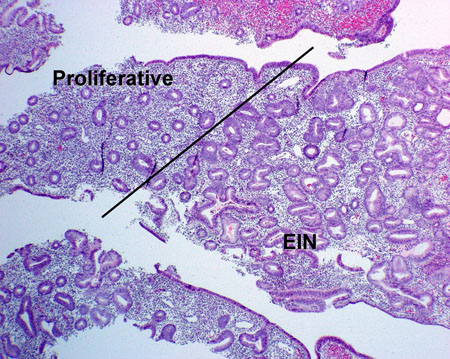
With the increasing use of progesterone receptor modulators (PRMs) such as mifepristone (RU486) for the management of endometriosis and uterine leiomyoma, the term 'PRM-associated endometrial changes' has been proposed; these histological changes in the endometrium should not be confused with EIN.[36]
Unopposed endogenous oestrogenic stimulation of the endometrium
Seen in chronic anovulation, which is a feature of polycystic ovary syndrome.
In post-menopausal women, oestrogens are primarily produced through peripheral aromatisation of androgens, particularly androstenedione, in adipocytes. Obesity increases the production rate of oestrogens by this mechanism.
Sex cord stromal tumours of the ovary, such as granulosa cell tumours, are also a source of endogenous estradiol.
Unopposed exogenous oestrogenic stimulation of the endometrium
Exogenous oestrogen therapy (e.g., hormone replacement therapy) in pre-menopausal and post-menopausal women is associated with endometrial hyperplasia and endometrial cancer.[34][37][38]
Familial cancer syndromes
Lynch syndrome (also known as hereditary non-polyposis colorectal cancer) is associated with mutations in DNA mismatch repair (MMR) genes (including MSH2, MLH1, MSH6, and PMS2) and deletions in the epithelial cellular adhesion molecule (EPCAM) gene.[39][40]
Family history of colorectal, endometrial, and/or ovarian cancer is often observed.[41][42]
Cowden syndrome, related to mutation in the PTEN tumour suppressor gene. Carriers have an increased risk for endometrial, breast, thyroid, colorectal, and renal cancer.[43]
Pathophysiology
There are a number of pathophysiological factors that may be associated with endometrial cancer.
Oestrogen: the ability of oestrogen to function as a mitogen is clear, while its ability to act as a mutagen in stimulating cellular division and organ growth is controversial. The former effects seem to occur via stimulation of the transcription of genes for cyclin D, proto-oncogenes, growth factors, and growth factor receptors. Oestrogen may affect the expression of genes, leading to altered regulation of cellular signals in the development of endometrial hyperplasia. Phosphatase and tensin homologue (PTEN) gene mutation with loss of expression of the PTEN protein is an early event in this progression, while mutations of ras and mismatch repair (MMR) genes occur later.[43][44][45][46]
PTEN tumour suppressor gene mutation: paraffin tissue immunohistochemistry with anti-PTEN antibody shows that over half of endometrioid endometrial adenocarcinomas, and their precursor EIN lesions, have lost PTEN protein.[47][48][Figure caption and citation for the preceding image starts]: Low-grade adenocarcinoma arising in proliferative endometrium, stained using immunohistochemistry (brown stain) for phosphatase and tensin homologue protein; note the negatively stained (non-brown) neoplastic glands (normal epithelium usually stains brown)From the collection of George Mutter MD, Division of Women's and Perinatal Pathology, Brigham and Women's Hospital, Harvard Medical School [Citation ends].

K-ras gene mutation: endometrioid adenocarcinomas, which are oestrogen-dependent (and account for 80% of all endometrial cancers), contain K-ras mutations in 24% of cases.[49]
Microsatellite instability and MMR genes: endometrioid adenocarcinomas, which are oestrogen-dependent, show microsatellite instability in 20% to 30% of cases.[50][51] Germline mutations in the MMR genes MLH1, MSH2, MSH6, and PMS2 can lead to the development of Lynch syndrome (hereditary non-polyposis colorectal cancer [HNPCC]). Deletions in the epithelial cellular adhesion molecule (EPCAM) gene can cause Lynch syndrome by silencing MSH2 expression. These mutations confer a strong susceptibility to cancer, including endometrial, ovarian, and colorectal cancer.[43][44][52]
p53 gene mutation: mutation of the p53 tumour suppressor gene is not found in endometrial hyperplasia, but can be detected in 20% of cases of endometrioid carcinoma and in more than 90% of serous tumours of the endometrium (which are oestrogen-independent and arise from atrophic, rather than hyperplastic, endometrium).[15]
HER-2/neu gene: over-expression or amplification of HER2 (encoded by the ERBB2 gene) in uterine serous carcinoma is associated with a poor prognosis. Uterine serous carcinoma, a biologically distinct subtype of endometrial cancer, is characterised by six major molecular genetic alterations including: TP53 mutation, PIK3CA activating mutation/amplification, ERBB2 amplification, CCNE1 amplification, FBXW7 inactivating mutation/deletion, and PPP2R1A inactivating mutation.[53]
Genome-wide association studies have identified additional candidate genes, which encode negative regulators of oncogenic signal transduction proteins, on chromosomes 12 and 17.[54]
Classification
WHO classification of tumours of the uterine corpus[1]
The 2020 WHO classification includes molecular classification, based on immunohistochemistry testing, alongside traditional histological categories. The impact of molecular classification on rarer non-endometrioid tumours is unclear; therefore, the focus is on molecular classification of endometrioid carcinoma.[2][3]
Endometrial epithelial tumours and precursors
Precursor lesions
Endometrial hyperplasia without atypia
Endometrial atypical hyperplasia/endometrioid intraepithelial neoplasia
Endometrial carcinomas
Endometrioid carcinoma of the uterine corpus: the most common subtype of endometrial cancer, present in up to 90% of cases, with histology showing recognisable malignant glands and glandular cells in the better-differentiated (low-grade) forms[4]
POLE-ultramutated endometrioid carcinoma
Mismatch repair (MMR)-deficient endometrioid carcinoma
p53-mutant endometrioid carcinoma
No specific molecular profile (NSMP) endometrioid carcinoma
[Figure caption and citation for the preceding image starts]: Histological subtype: endometrioid endometrial adenocarcinoma, the most common subtype; diagnosed on dilation and curettage in a patient presenting with post-menopausal bleeding (photomicrograph, haematoxylin and eosin stain)Courtesy of Professor Robert H. Young, Department of Pathology, Massachusetts General Hospital [Citation ends].
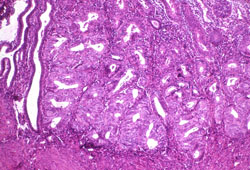
Serous carcinoma of the uterine corpus[Figure caption and citation for the preceding image starts]: Histological subtype: uterine papillary serous carcinoma with typical small papillae and slit-like spaces.(photomicrograph, haematoxylin and eosin stain)Courtesy of Professor Robert H. Young, Department of Pathology, Massachusetts General Hospital [Citation ends].
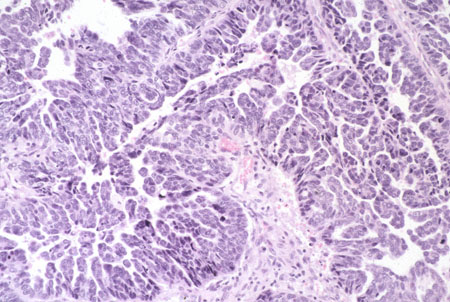
Clear cell carcinoma of the uterine corpus (1% to 6% of cases)[5][6][7][Figure caption and citation for the preceding image starts]: Histological subtype: clear cell adenocarcinoma (photomicrograph, haematoxylin and eosin stain)Courtesy of Professor Robert H. Young, Department of Pathology, Massachusetts General Hospital [Citation ends].
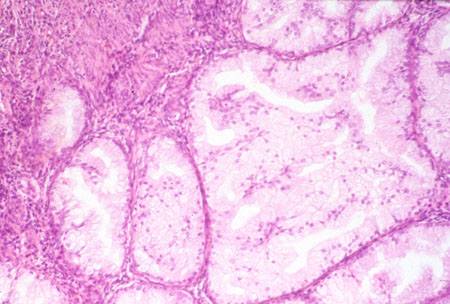
Undifferentiated carcinomas of the uterine corpus
Mixed cell adenocarcinoma of the uterine corpus
Other rare endometrial carcinomas: squamous cell carcinoma, mesonephric adenocarcinoma, mucinous carcinoma (intestinal type), mesonephric-like adenocarcinoma
Carcinosarcoma of the uterine corpus
Tumour-like lesions
Endometrial polyp
Endometrial metaplasia
Arias-Stella reaction of the uterine corpus
Mesenchymal tumours of the uterus
Smooth muscle tumours
Uterine leiomyoma
Intravenous leiomyomatosis
Smooth muscle tumour of uncertain malignant potential of the uterine corpus
Metastasising leiomyoma
Uterine leiomyosarcoma
Endometrial stromal and related tumours
Endometrial stromal sarcoma, low grade
Endometrial stromal sarcoma, high grade
Endometrial stromal nodule
Undifferentiated endometrial sarcoma
Miscellaneous mesenchymal tumours
Uterine tumour resembling ovarian sex cord tumour
Perivascular epithelioid cell tumour (PEComa)
Inflammatory myofibroblastic tumour
Other mesenchymal tumours of the uterus
Mixed epithelial and mesenchymal tumours
Adenomyoma of the uterine corpus
Atypical polypoid adenomyoma
Adenosarcoma of the uterine corpus
Miscellaneous tumours
Tumours of germ cell type
Central primitive neuroectodermal tumour/central nervous system embryonal tumour
International Federation of Gynecology and Obstetrics (FIGO) histological grading[8][9]
Endometrial cancers are primarily classified as endometrioid versus non-endometrioid. Endometrioid cancers constitute the majority, are most commonly present as early stage grade 1-2, are often hormone dependent, and have a more favourable clinical course. Grade 3 endometrioid cancers are more mixed and generally have a less favourable prognosis.
Non-endometrioid cancers are more aggressive serous cancers, clear cell cancers, and carcinosarcomas that are typically at higher risk of early distant spread.[9]
Histopathological grades:
GX: Grade cannot be assessed
G1: Well differentiated
G2: Moderately differentiated
G3: Poorly differentiated or undifferentiated.
Degree of differentiation is another basis for classification:
Grade 1 (G1): non-squamous or non-morular solid growth pattern of ≤5%[Figure caption and citation for the preceding image starts]: Grade 1 or low-grade endometrioid adenocarcinoma (right) on background of proliferative endometrium (left); (photomicrograph, haematoxylin and eosin stain)Courtesy of Professor Robert H. Young, Department of Pathology, Massachusetts General Hospital [Citation ends].
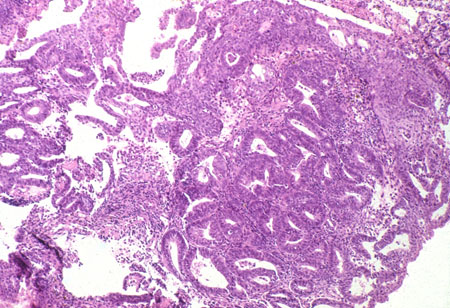
Grade 2 (G2): non-squamous or non-morular solid growth pattern of 6% to 50%
Grade 3 (G3): non-squamous or non-morular solid growth pattern of >50%. [Figure caption and citation for the preceding image starts]: Grade 3 or high-grade endometrioid adenocarcinoma on a background of atrophic endometrium (photomicrograph, haematoxylin and eosin stain)Courtesy of Professor Robert H. Young, Department of Pathology, Massachusetts General Hospital [Citation ends].
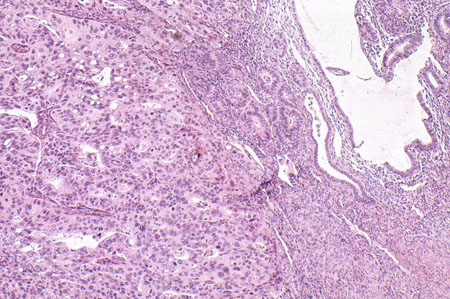
Generally, G1 and G2 are low grade and G3 is high grade.
Patient phenotype, I or II
Type I endometrial carcinoma:
Most commonly seen in the classical clinical setting of an obese patient with hyperlipidaemia, hyperoestrogenism, insulin resistance, and infertility
Also common in women with uterine bleeding and late onset of menopause associated with oestrogen-induced endometrial hyperplasia
These lower-grade hormone receptor-positive endometrioid cancers more commonly occur in younger women.[10]
Type II endometrial carcinomas:
More typically arise in atrophic endometrium in older women
Associated with TP53 mutations
Tumour hormone receptor status[11]
Oestrogen receptor (OR) and progesterone receptor (PR) status is only evaluated for potential palliative use of hormonal therapy in advanced or recurrent tumours, but does have prognostic value:
Presence of OR (OR positive)
Presence of PR (PR positive)
Clinical response to a trial of a progestin (typically medroxyprogesterone).
Tumour biomarker status
Used increasingly in order to sub-classify endometrial carcinoma and for the purposes of treatment and prognosis.
Loss of the tumour suppressor phosphatase and tensin homologue (PTEN) gene has been reported in 30% to 50% of type 1 cancers, but is rarely observed in serous cancers.[13][14][15]
The proto-oncogene HER2/neu, a transmembrane growth factor receptor, is commonly amplified or over-expressed in serous cancers, and is associated with poor survival.[16][17][18][19][20]
Serous tumours also have high rates of p53 mutation, less commonly observed in type 1 and lower-grade tumours.
Commonly used biomarkers can be detected by most surgical pathology laboratories using immunohistochemistry on tissue sections:
PTEN[Figure caption and citation for the preceding image starts]: Low-grade adenocarcinoma arising in proliferative endometrium, stained using immunohistochemistry (brown stain) for phosphatase and tensin homologue protein; note the negatively stained (non-brown) neoplastic glands (normal epithelium usually stains brown)From the collection of George Mutter MD, Division of Women's and Perinatal Pathology, Brigham and Women's Hospital, Harvard Medical School [Citation ends].

Mismatch-repair genes MLH1, MSH2, MSH6, and PMS2
p53
HER-2
Phospho-AKT (controversial).
The Cancer Genome Atlas (TCGA) classification[21]
TCGA research network characterised 373 endometrial carcinomas using array- and sequencing-based technologies, and proposed the following four distinct molecular subgroups of endometrial carcinoma:
POLE gene ultramutated (endometrioid carcinomas with POLE mutations)
Microsatellite instability hypermutated (endometrioid carcinomas with microsatellite instability)
Copy-number low (endometrioid carcinomas with a low degree of copy-number alterations)
Copy-number high (predominantly serous, but also serous-like endometrioid carcinomas with a high degree of copy-number alterations and frequent TP53 mutations).
Molecular profiling is increasingly preferred to morphological classification to inform prognosis and treatment-related decisions.[9] Molecular classification is being integrated into national and international guidelines.[9]
Proactive Molecular Risk Classifier for Endometrial Cancer (ProMisE)[22]
The novel molecular classifier ProMisE assigns patients with endometrial cancer to one of four groups based on a combination of mutation and protein expression analyses. The first assessment is immunohistochemistry to determine the presence or absence of mismatch repair proteins (to identify MMR deficiency [MMR-D]), enabling a rapid referral to hereditary cancer programmes.
Tumours are then assessed for POLE mutations, and finally for protein 53, resulting in four subgroups:
MMR-D - Mismatch repair (MMR) deficient
POLE EDM - Polymerase-e (POLE) exonuclease domain mutations (EDMs)
P53 wt - Protein 53 (p53) wild type (wt)
P53 abn - Protein 53 null/missense mutations.
Use of this content is subject to our disclaimer